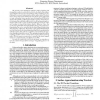Free Online Productivity Tools
i2Speak
i2Symbol
i2OCR
iTex2Img
iWeb2Print
iWeb2Shot
i2Type
iPdf2Split
iPdf2Merge
i2Bopomofo
i2Arabic
i2Style
i2Image
i2PDF
iLatex2Rtf
Sci2ools
VISUALIZATION
1995
IEEE
1995
IEEE
Fast Multiresolution Surface Meshing
We present a new method for adaptive surface meshing and triangulationwhichcontrolsthelocallevel–of–detailofthesurface approximation by local spectral estimates. These estimates are determined by a waveletrepresentation of the surface data. The basic idea is to decompose the initial data set by means of an orthogonal or semi–orthogonal tensor product wavelet transform (WT) and to analyzetheresultingcoefficients.Insurfaceregions,wherethepartialenergyoftheresultingcoefficientsislow,thepolygonalapproximation of the surface can be performed with larger triangles without loosing too much fine grain details. However, since the localizationoftheWTisboundbytheHeisenbergprinciplethemeshing method has to be controlled by the detail signals rather than directlybythecoefficients.ThedyadicscalingoftheWTstimulated ustobuildanhierarchicalmeshingalgorithmwhichtransformsthe initially regular data grid into a quadtree representation by rejectionofunimportantmeshvertices.Theoptimumtriangulationoft...
Adaptive Surface Meshing | Local Spectral Estimates | Surface Data | Visualization | VISUALIZATION 1995 |
Related Content
| Added | 26 Aug 2010 |
| Updated | 26 Aug 2010 |
| Type | Conference |
| Year | 1995 |
| Where | VISUALIZATION |
| Authors | Oliver G. Staadt, Markus H. Gross, Roger Gatti |
Comments (0)

